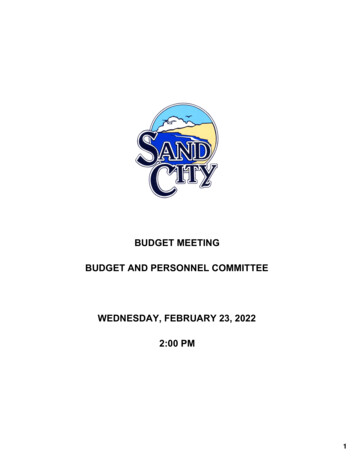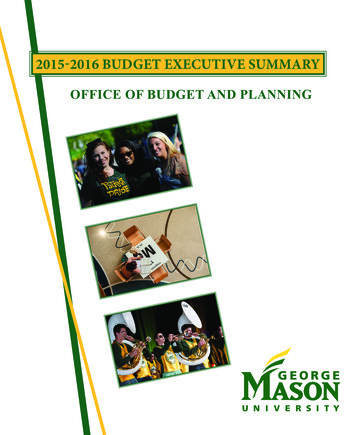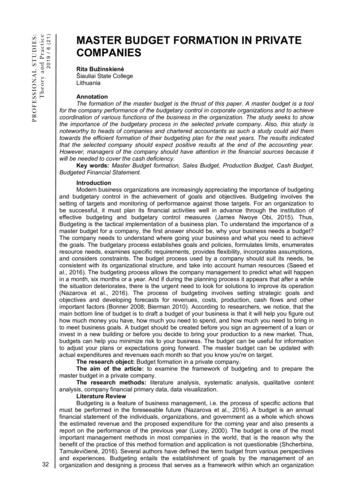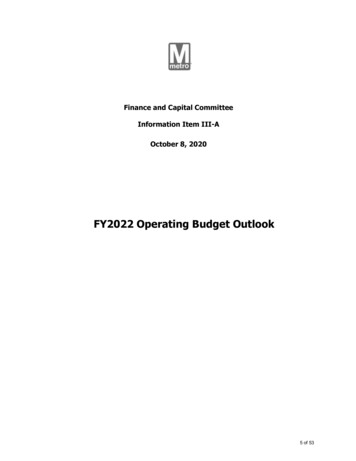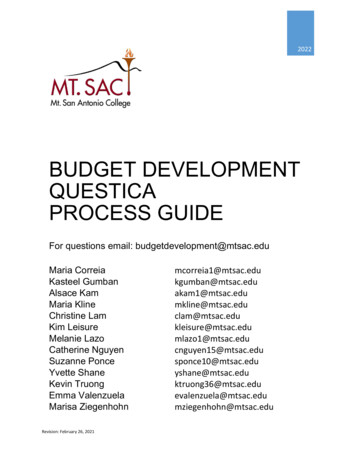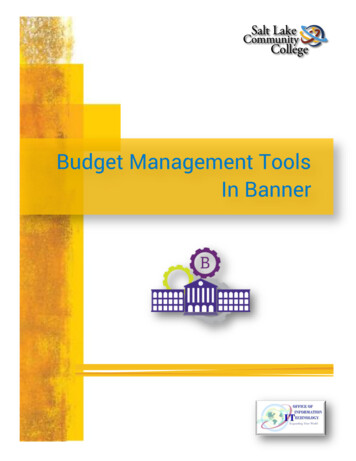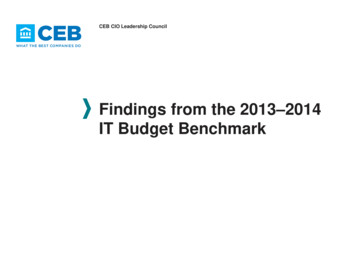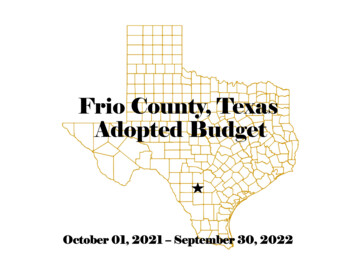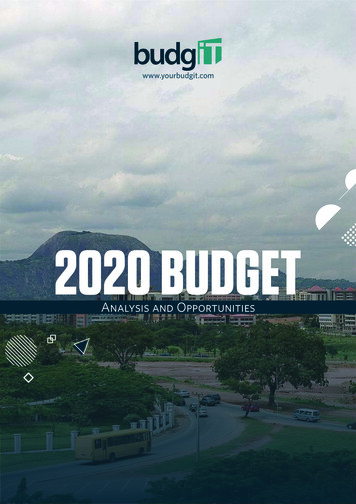
Transcription
www.yourbudgit.com2020 BUDGETAnalysis and Opportunities
About BudgITBudgIT is a civic organisation driven to make the Nigerian budget andpublic data more understandable and accessible across every literacyspan. BudgIT’s innovation within the public circle comes with a creativeuse of government data by either presenting these in simple tweets,interactive formats or infographic displays. Our primary goal is to usecreative technology to intersect civic engagement and institutionalreform.Principal Lead: Gabriel OkeowoResearch Team: Ojiugo Uche, Olaniyi Olaleye, Oyebola Agunloye,Damilola Onemano, Thaddeus Jolayemi and Oluwatosin IseniyiCreative Development: Segun AdeniyiContact: info@yourbudgit.com 234-803-727-6668, 234-908-3331633Address: 55, Moleye Street, Sabo, Yaba, Lagos, Nigeria. 2020Disclaimer: This document has been produced by BudgIT to provideinformation on budgets and public data issues. BudgIT hereby certifiesthat all the views expressed in this document accurately reflect ouranalytical views that we believe are reliable and fact- based.Whilst reasonable care has been taken in preparing this document, noresponsibility or liability is accepted for errors or for any views expressedherein by BudgIT for actions taken as a result of information provided inthis Report.2020 APPROVED BUDGET ANALYSIS03
Abbreviations/AcronymsAfCFTA African Continental Free Trade AreaBHCPFBasic Health Care Provision FundBIRBudget Implementation ReportbnBillionBOFBudget Office of the FederationCAPEXCapital ExpenditureCBNCentral Bank of NigeriaCITCorporate Income TaxERGPEconomic Recovery and Growth PlanFECFederal Executive CouncilFGFederal GovernmentFIRSFederal Inland Revenue ServiceFYFiscal YearGDPGross Domestic ProductGFCFGross Fixed Capital FormationGOEGovernment Owned EnterpriseIMFInternational Monetary FundINECIndependent National Electoral CommisionJVJoint VenturesmbpdMillion barrels per dayMDAMinistries, Departments and AgenciesmnMillion2020 APPROVED BUDGET ANALYSIS04
MTEFMedium Term Expenditure FrameworkN/ANot AvailableNBSNational Bureau of StatisticsNEDCNorth East Development CommissionNHRCNational Human Rights CommissionNJCNational Judicial CouncilNLCNigerian Labour CongressNNPCNigerian National Petroleum CorporationONSAOffice of the National Security AdviserQ3Third QuarterSMESmall and Medium - Sized EnterprisesTINTax Identification NumbertnTrillionUBEUniversal Basic EducationUNESCO United Nations Education, Scientific and Cultural OrganizationVATValue Added TaxWHOWorld Health Organizationy- o- yYear on YearZIPZonal Intervention Projects2020 APPROVED BUDGET ANALYSIS05
Table of contentsKEY ASSUMPTIONS7INTRODUCTION8FISCAL FRAMEWORK10REVENUE11Oil RevenueNon-Oil RevenueValue Added TaxCompany Income TaxCustoms (Import, Export & Fees)Independent and Other revenues121314161617EXPENDITURES19Recurrent Expenditure20Personnel CostOverhead Cost2122Debt ServicingStatutory TransfersCapital Expenditure222323SECTORAL Humanitarian and Disaster ManagementSecuritySpecial InterventionsRoad InfrastructureRailway303132333334373839CONCLUSION AND RECOMMENDATIONS402020 APPROVED BUDGET ANALYSIS06
Key Assumptions of the 2020 Budget FrameworkOilProduction N2.18mbpdOil Price 57/bExchangeRateN305/ GDP 22.75tnNominalGDPN142.75tn2.93%2020 APPROVED BUDGET ANALYSIS07
IntroductionThe beginning of the new decade presents anopportunity for Nigeria to re-position its economy forprosperity. However, if the new decade will be adecade of growth, the judicious implementation of the2020 budget is important. Despite Nigeria’s recordquarterly GDP growth of 2.55% in Q4 2019, inflationremains high and the future foreign investments arejeopardised by demotion in credit ratings1. To leadNigeria to a prosperous decade, the governmentthrough all stages of the budget process—formulation,approval, implementation and oversight—must workto increase citizen trust, decrease unnecessaryspending while aggressively increasing revenue with aconscientiously executed plan.After the 2019 elections, the Nigerian governmentunder President Muhammadu Buhari has anotherchance to face governance with undivided attention. Inthe last decade, Nigeria’s budget calendar has beeninconsistent, with the budget passed as late as Junethe following year. This has created chaoticimplementation of capital projects and also delayedthe audit of public finances. The 2020 budget waspresented on October 8, 2019, and in the shortestcycle since 1999, the budget was signed into law onDecember 17, 2019. While the speedy passage of thebudget is commendable, it is important to zoom in onthe specific details of the budget items and what thebudget means for the citizenry and the economy atlarge.Nigeria’s real quarterly GDP growth, as at Q4 2019,stood at 2.55% and brought the 2019 GDP growth to2.27% - the highest since the 2016 recession, This isnevertheless less than the target projection of 4.5% inthe Economic Recovery and Growth Plan (ERGP) andeven lesser than the 2019 budget target of 3.5%. Theshortfall against these targets have tempered the2020 budget GDP growth target to 2.93%—a far cryfrom the ERGP’s proposed 7% growth in 2020.The prices of goods and services are also on theincrease, therefore straining the purses of Nigerians.January 2020’s year-on-year inflation rose to 12.13%— the highest y-o-y change since May 20182.Inflation is likely to remain high due to two factors.First, the new minimum wage is likely to cause furtherwage-push inflation in 2020, making the budget targetof 10.81% unlikely. Second, the strain and adjustmentto the land border closure is also a contributing factorto inflation. This paints an unappealingmacroeconomic picture, when paired with belowtarget GDP growth and Nigeria’s Q3 2018 labourstatistics which shows that 55.4% of the youngpopulation aged 15-34 years are unemployed orunderemployed.In terms of future investments, the downgrading ofNigeria’s credit ratings from stable to negative by theinternationally renowned Moody’s Investors Services3makes it even more difficult for the country to accessforeign investments that are sorely needed to increaseeconomic growth. This also threatens Nigeria’s recentGross Fixed Capital Formation (GFCF) gains which sawan increase from 14.7% of GDP in 2017 to 19.0% ofGDP in 2018. The GFCF measures the net increase infixed capital—a key metric that should be on theincline for Nigeria with her infrastructure deficit.Since 2016, Nigeria has continued to provideexpansionist budgets, with its budget having risenfrom the N4tn mark in early 2010s to above 6tn since2016. This does not mean that Nigeria has notsignificantly improved its revenue position as itsrevenue-to-GDP is still less than 8%. The FederalGovernment of Nigeria has resorted to large unfundeddeficit through large borrowings from the Central Bankof Nigeria (CBN) and also raised its debt on acontinuous trajectory. While there have beenimprovements in the Company Income Tax, ValueAdded Tax, Customs and other revenue lines, they -PR 413627National Bureau of -from--PR 413627232020 APPROVED BUDGET ANALYSIS08
not enough to counterbalance the rising recurrentcomponent of the budget.The challenges that Nigeria continues to face aremainly the paucity of its revenue and poor institutionalinterest to apply efficiency to its expenditure. Nosignificant cuts have been made to its overheads andits opaque statutory spending has continued to surge.For instance, after a long negotiation with the NigerianLabour Congress (NLC), Nigeria finally agreed to raiseits minimum wage to N30,000 ( 85), whichsignificantly adds over N600bn to FG’s personnelcost, further increasing an already bloatedexpenditure budget.The current state of Nigeria’s budget reveals thespectre of a country that severely underinvested inhealth and education in previous years. As a result ofthis, the FG budget has increasingly spent onmanaging its socio-economic and humanitarianchallenges. Nigeria now allocates N1.78tn to security,with over N900bn in defence and N453bn onhumanitarian, disaster and social development issuesthrough the newly minted Ministry of HumanitarianAffairs, Disaster Management and SocialDevelopment.It is pertinent to know that the FG still spends less than11% on its education and health sector combined.While it has been identified that human capitalinvestment is crucial to maintain a healthy andadvanced society, Nigeria’s current budgetarytrajectory does not reveal such understanding. Nigeriais putting a huge chunk of its investments in roads,railway and power, which gulp 23% of its capitalexpenditure.As Nigeria faces huge revenue challenges, the currentCBN support may be unsustainable, even though thecountry is revising its taxation codes. Nigeria raised itsVAT rate from 5% to 7.5% and also provided certainfiscal measures that exempts small businesses fromVAT registration and CIT payments. While an increase11%in VAT might be a way forward, the current VATdistribution architecture (85% for the states), favoursthe states more than the federal government. It ishighly uncertain that the current taxation review willmake a significant dent on public revenues as theNigerian government keeps focusing on revenuegrowth through increased extraction from the weakeconomy, rather than focusing on economic growththat yields more taxable income.The Nigerian government also needs to be truthfulwith its revenue numbers as most of the “otherrevenues” such as sale of signature bonus, funds fromrecovered stolen assets, sale of shares in Joint Venture(JV) assets have not been realised. These items havejust been used to shore up its revenue projections,creating a false estimation of its fiscal deficit. Forexample in 2018, while Nigeria planned a deficit ofN1.95tn in its approved budgets, it ended up with aN3.64tn deficit, according to budget implementationreports. The recent budget implementation reportshave also falsely included “balances of specialaccounts” as part of revenues. N1.3tn was accountedfor as “actual balance in special account” as ofSeptember 2019, significantly reducing the deficit.This does not help in putting forward the dire situationof Nigeria’s revenue challenge.Finally, it is important to pay attention to rising debtservicing costs which are higher than Nigeria’s capitalexpenditure. FG debt servicing expense was a high45.2% of its revenue, as of September 2019, ananomaly even in countries with extremely high debtto-GDP ratio. Nigeria is currently on the cusp ofborrowing approximately 30bn, a position that woulddouble its foreign debt. The certainty in Nigeria’sbudget timeline should aid capital budgetimplementation but this fiscal document does notsolve the triple challenge of rising recurrent costs, lowrevenue and escalating debt numbers.It is pertinent to know that the FG still spendsless than 11% on its education and health sectorcombined.2020 APPROVED BUDGET ANALYSIS09
2020 Approved N(Non-Debt)1.81tnNon-OilRevenue2.64tnOil Revenue3.97tnOther RevenueSourcesIncludes Dividends,Recoveries/Fines,Independent Revenue,Signature Bonus, etc.Source: Budget Office
Revenue2020 APPROVED BUDGET ANALYSIS11
Oil RevenueFederal Government ShareDespite the increase in crude oil prices, oil revenuedeclined relative to the projected budget estimatesdue to shortfalls in crude oil production and exports.This has arisen from Nigerian OPEC output targetswhich are sometimes below budget benchmarks4,recent increased global competition from US oil5, andJuly 2019 closure of a major offtaking refinery abroad6.In the 2018 and 2019 budgets, the federalgovernment’s oil production projection stood at 2.3million barrels per day (mbpd) but actuals fell short atan average 1.93mbpd in 2018 and 1.96mbpd by Q32019. The low performance of this sector hassignificantly affected Nigeria’s oil revenue whichaccounts for about 71% of the total federally collectedrevenue.In 2018, only about N1.96tn was realised from thefederal government oil shares revenues, out ofN2.98tn proposed for the year. Similarly, the federalgovernment’s aggregate data for share of oil revenuefor Q3 2019 performed at 52%.Despite the government’s promise to diversify theeconomy, oil revenue still accounts for a significantpart of Nigeria’s revenue. More attention should begiven to increase oil production and eliminate vandals’activities in the Niger Delta region to increase crude oilproduction to meet its oil production target.Even though Nigeria is blessed with vast mineralresources for large scale production and export whichcan provide alternative sources of revenue, the countryseems fixated on oil. As such, it is also important tostart looking beyond oil for alternative sources ofincome for the nation.FG Share of Oil Revenue (2015-2020)Budget (NGN Billion)Actual (NGN Billion)2,988Even though, N3.68tn was projected from oil revenuefor the 2019 full year but the budget performancereport for the year, released by the Ministry of Financecovers January to September with prorated data for oilrevenue target arriving at N2.76tn, only N1.4tn wasrealised within the same period.The average price of crude oil in the 2020 proposedbudget was projected at 57 per barrel and presently,the fundamentals of the 2020 budget is beingthreatened as brent crude oil price has slumped to 54per barrel as at February 6, 2020, below nation’sbudget benchmark. This could have a significant effecton Nigeria’s oil revenue target at the end of the 2020fiscal 697.820152016201720182019*2020*Prorated January-September 20194Aljazeera News; September, 2019 - mlReuters, August, 2019 - idUSL8N2535F56Reuters, July, 2019 - -light-sweet-crude-idUSKCN1UE1NN52020 APPROVED BUDGET ANALYSIS12
Non-Oil RevenueSince the beginning of commercial oil exploration inNigeria, oil revenue has accounted for a major chunk ofrevenue expectations and projections, however, nonoil sources of revenue are increasingly becomingimportant to the economy. Consequently, the federalgovernment under the Buhari administration has beenkeen on prioritising and improving its non-oil revenueperformance in 2020.History of Federal Government Shareof Non-Oil RevenueBudget (NGN Billion)Actual (NGN Billion)1,8051,6301,567For the 2020 fiscal year, the federal government hasprojected its uptake of non-oil revenue to be in theregion of N1.81tn. This projected amount comes in at28% higher than the N1.41tn passed by the NationalAssembly for the 2019 fiscal year; revealing the usualoptimism of the federal government in theperformance of its non-oil revenue bracket. Withoutsounding less optimistic than the federal government,history shows that actual non-oil revenues by the FGover the years has usually failed to meet its forecast,falling short of its expected revenue projections.For instance, in 2018, the FG’s actual non-oil revenueuptake fell short of its expected projection by almost31%. Likewise in 2019, FG’s prorated share of budgetednon-oil revenue uptake for the first nine months waspegged at N1.056tn, but actual revenue uptake withinthis period came to a total of 16201720182019*2020**Pro-rata; Jan-Sept, 2019Nonetheless, the federal government is quite sanguineabout its non-oil revenue uptake in 2020, particularlyin the area of tax revenue like value-added tax, via therecently assented finance bill of 2019.2020 APPROVED BUDGET ANALYSIS13
Value Added TaxFGN Share of VATThe federal government earned N146.52bn in the year2018, as against a projected figure of N207.51bn. TheFG’s share of VAT revenue was N172.53bn, N198.24bn,and N241.92bn in 2015, 2016 and 2017 respectively.However, projected VAT in 2020 was increased toN292.bn against the 2019 budget figure of N229.34bndue to the plans of the federal government to raise thetax rate in the year 2020.VAT Rate in Selected Countries15.0%12.5%16.0%14.0%7.5%Projected and Actual VAT2015- 2020Budget (NGN Billion)GhanaKenyaNigeriaThe new 7.5% VAT rate is an increase that movesNigeria’s rate closer to that of its peers. There ishowever a question about how much the Federalgovernment will accrue based on this increase sincethe VAT exemption list was expanded by the 1109.0104.7N/A2016EgyptActual (NGN Billion)292.62015SouthAfrica201720182019*2020The federal government’s share of the collected VAT15% - the lowest out of all three tiers of executivegovernment. With state governments’ share of VAT at50%, they stand to be the biggest beneficiaries of thisincrease in VAT.*Pro-rata; Jan-Sept, 2019The Federal Executive Council (FEC), approved a 50%increase in the Value Added Tax (VAT) rate, applicableon supply of goods and services in Nigeria, from 5% to7.5%. The new rate took effect in January 2020.Despite this increase, VAT rates in our key regionalpeers are higher than Nigeria’s with rates in Kenya,South Africa, Egypt and Ghana at 16%, 15%, 14% and12.5% respectively.Share of Collected VAT by level ofGovernmentStateLocal50%35%Federal15%2020 APPROVED BUDGET ANALYSIS14
What would an increase in VATrate from 5% to 7.5% mean for eachstate IGAWABAUCHIANAMBRAOGUNIMOBENUEAKWA BIADAMAWAZAMFARAABIACROSS SAAverage monthly net VAT allocation(Jan - June 2019)Additional monthly VAT allocationgiven VAT rate of 4Source: NBS, BudgIT AnalysisIf current collection rates remain the same*Based on this, state governments should expect amonthly increase in revenue of between N0.4bn andN4.1bn if the current collection rates remain the sameas shown above. An increase in state inflowssomewhat reduces the budgetary burden on thefederal government (e.g. in the area of education).2020 APPROVED BUDGET ANALYSIS15
Company Income TaxCIT is one of the major sources of the federalgovernment’s revenue in the non-oil sector. Over thelast five years, the federal government has witnessedan improvement in CIT collection rate. In the 2019financial year, the FG projected the sum of N813.37bnfrom company income tax, but as at the 3rd quarter of2019 half-year budget implementation report, theactuals between January and September wasN595.27bn which shows 97% of the prorated target ofN610.02bn.FGN Share of the Company Income Tax(2015-2020)Budget (NGN Billion)Actual (NGN Billion)839807794867In the 2020 approved budget, the FG is targeting anestimate of N839.31bn from CIT, a slight increasefrom the 2019 figure of N813.37bn. In the 2018 full-yearreport, the FG got an actual amount of N660.13bn, thatis 83% of the target for the fiscal year. For the FG toimprove this source of revenue, private sector growthshould be prioritised by improving infrastructuregrowth and ease of doing business.660651610 59554347320154572016201720182019*N/A2020*Prorated January - September, 2019Customs (Import, Exports & Fees)In the 2020 approved budget, the federal governmenthas projected the sum of N618.65bn as customs andexcise duties which is a large increase of N307.78bnfrom the N310.87bn target for 2019.Customs and excise duties are key components ofNigeria's non oil sector, and over the past five years, thecountry has witnessed significant uptake in tariffs andduties. In 2015 and 2016, customs actual payments tothe federal government stood at N232bn andN228.61bn against the budget projections ofN323.97bn, and N326.4bn respectively.Between 2017 and 2018, the collection rates wereabove 90% of the budget target as both receivedactuals of N261.41bn and N296.74bn respectively. Andby the third quarter of 2019, the customs dutiescollected stood at N265.81bn which was N32.66bnhigher that the prorated budget target of N233.15bn.From the Budget Implementation Reports, in 2018,customs revenue reported to the federation accountwas N657.88bn, while N296.74bn was the federalgovernment’s share of it. This shows a great disparityfrom the N1.2tn collected customs revenue reportedin Nigerian newspapers*.The disparity of what the Nigerian Custom Serviceannounces compared to what was remitted to thefederation account is too wide, hence in need ofreview.In 2019, Nigeria signed the African Continental FreeTrade Area (AfCFTA) agreement. This agreement wassigned by African states to increase intra-Africantrade and create a continental market allowing for thefree movement of goods, services, capital and persons.However, just a few months after signing theagreement, the FG closed its land borders for all sentiments/2020 APPROVED BUDGET ANALYSIS16
defying the AfCFTA’s agreement. Despite the borderclosure, customs revenues have grown but this doesnot signal that the practice is in Nigeria’s long terminterests as the country grapples with sub-3% GDPgrowth.Federal GovernmentShare of Customs RevenueBudget (NGN Billion)Actual (NGN 2233.2228.6N/A20152016201720182019*2020*Pro-rata; January-September, 2019Independent & Other RevenueAbout 80% of the operating surplus that comes fromGOEs is captured under independent revenue. In2015, 2016, 2017 and 2018, the federal government fellshort of their independent revenue forecasts by33.91%, 84.21%, 63.43%, 53.39% respectively.January to September, 2019 breaks this streak asactual independent revenue came to N506.8bn surpassing the pro-rata January to September targetof N473.3bn.In 2020, the FG projects N849.97bn from independentrevenue, 35% higher than the 2019 figure of N631.1bnin 2019. This makes independent revenue 10.42% ofActual (NGN Billion)1,505.9The federal government is also expecting revenue fromthe top ten Government-owned Enterprises (GOEs)excluding the NNPC, and it is expected that therevenue will increase by N34.8bn or 4% in 2020, fromthe N955.4bn expected in 2019 to N990.1bn in the2020 fiscal year.849.9847.9807.6489.3395.2323.4237.8In addition, the federal government plans to generateN3.97tn from other sources including recoveries,dividends, fines, signature bonuses, independentrevenue and others. This includes a 1015 % incrementin signature bonus from the 2019 figure of N84.2bn toN939.3bn.From domestic recoveries, fines and assets, N237bn isexpected in 2020 as against the N203.3bn projected in2019. A total of N463.9bn is expected from stampduties and N125.5bn and N36.3bn from exchange ratedifferentials and grant and donor funding respectively.Budgeted and Actual IndependentRevenue (2015-2020)Budget (NGN Billion)total expected federal government revenue in 2020. Tomeet these targets, the federal government will have toinnovate in boosting revenue, reducing leakages andensuring that revenue generating agencies ofgovernment remit what is due to the government.473.3 506.8295.3N/A20152016201720182019*2020*Pro-rated data; Jan - Sept. 20192020 APPROVED BUDGET ANALYSIS17
Using “other revenues” to shore up Nigeria’s revenueprojections has been the practice but these items havenot been realised. Since 2016, the FG has added oneoff items to augment the revenue position but it has notshown enough political will and institutionalframework to deliver the revenue component. The2020-2023 MTEF draft document in its analysis of the2018 budget performance also noted that “Thesignificant deviation of the overall revenueperformance from the target was partly because someone-off items such as the N710bn from Oil JointVenture Asset restructuring and, N320bn fromrevision of the Oil Production Sharing Contractlegislation/terms did not materialise.”To stop a repeat of this non-performance, in 2020, theFederal Executive Council/Economic ManagementCouncil should set up a committee which will work withwider public sector stakeholders—the AttorneyGeneral of the Federation, Ministry of Finance, theEconomic and Financial Crimes Commission, theCentral Bank of Nigeria and Nigerian PostalService—towards the realisation of the one-offrevenue items.A History of “Other Revenues” (Nbn)Item2018Budget2019Actual2019BudgetQ1-Q3 2019*Actual2020BudgetSignature Bonus114.30.084.21.2939.3Domestic Recoveries Assets Fines374.00.0203.30.0237.0Other FGN Recoveries138.40.0---Earmarked Funds (Proceeds of OilAssets Ownership)710.00.0710.00.0-Stamp Duties----463.9Grant and Donor Funding--209.90.036.3*Pro-rata data Jan-Sept 20192020 APPROVED BUDGET ANALYSIS18
Expenditure2020 APPROVED BUDGET ANALYSIS19
Expenditure AnalysisThe Muhammadu Buhari-led administrationproposed a total amount in the region of N10.59tn forall ventures under its expenditure obligations for thenew budget year 2020. The total expenditure amountat N 10.59tn is inclusive of Government-OwnedEnterprises (GOEs) and project-tied loans. This is2.6% (N263.94bn ) more than the initially proposedamount of N10.33tn which was presented by thepresident to the National Assembly for deliberation.Recurrent obligation of the federal government isprojected to gulp a total of N4.84tn, about 45.7% ofthe total budget; while aggregate capital expenditurecomes to a total of N2.78tn, 26.2% of the totalexpenditure figure. According to the federalgovernment, the noticeable increase in the recurrentexpenditure cost which comes in as about 10% higherthan the 2019 figure reflects the recent increase insalaries and pensions, including provision for theimplementation of the newly enacted minimum wagefor public servants and workers.Capital expenditure—inclusive of capital componentsof statutory transfers, alongside government ownede n t e r p r i s e s c a p i t a l a n d p ro j e c t t i e d l o a n sexpenditure—has been projected to be in the region ofN2.78tn. This is 12.6% lower than the projectedamount for the 2019 fiscal year. In 2019, aggregatecapital expenditure projection as passed by theNational Assembly came to N3.18tn.Nominal debt service allocation continues to be on therise, increasing by 14.5% from the amount allocated in2019. As it stands, debt servicing obligations forY2020 is expected to cost the federal government23.2% of its total expenditure at N2.45tn, which isalmost close to the amount allocated for capitalexpenditure for the same fiscal period. As atSeptember 2019, debt servicing cost the federalgovernment N1.92tn alone.A further breakdown of the total expenditureallocation stipulates a total amount of N560.4 bnwhich has been set aside for statutory transfers; thefigure is higher than the initial proposed figure by 0.7%.N272.9bn has been earmarked by the federalgovernment for sinking funds which, according to thepresident, will be used to retire maturing bonds issuedto local contractors. In order to meet its total recurrentobligations, the federal government will need to sourcefor additional funding, which will help to shore up itsinsufficient revenue. The federal government hasoptimistically projected its total revenue for the budgetyear 2020 to be in the region of N8.42tn, and with totalexpenditure put at N10.59tn, this gives rise to a fiscaldeficiency of N2.18tn which the federal governmentwill need to plug into its revenue stream to ensureabove par budget performance.Allocations to various Ministries, Departments andAgencies (MDAs) saw the Ministry of Defence comeout top of the pack with the highest allocation atN900.7bn; with N784.5bn earmarked for its recurrentactivities and N116.1bn set out for capital expenditure.The Ministry of Education comes in second highestwith a total allocation of N 686.82bn, while theMinistry of Health got a total of N469.24bn.Recurrent ExpenditureWithout sounding like a broken record, the federalgovernment’s recurrent obligation continues to be onthe rise, and with the newly implemented minimumwage for public servants, projected recurrentexpenditure for the budget year 2020 is expected to be10.3% higher than 2019 projections. The growing cost2020 APPROVED BUDGET ANALYSIS20
of governance, particularly in the area of personnelcost, gratuities and pensions continues to be a sourceof concern. On one hand, the federal governmentcannot afford to not pay its public servants their duewages and gratuities.On the other hand, personnel cost which as of 2018was an estimated 400,000-strong7 civil service,representing about 0.2% of the total population ofNigeria, will gulp almost 27% of the national budget forthe 2020 fiscal year. More worrying is the fact that thefederal civil service is p
The 2020 budget was presented on October 8, 2019, and in the shortest cycle since 1999, the budget was signed into law on December 17, 2019. While the speedy passage of the budget is commendable, it is important to zoom in on the specific details of the budget items and what the budget means for the citizenry and the economy at large.

